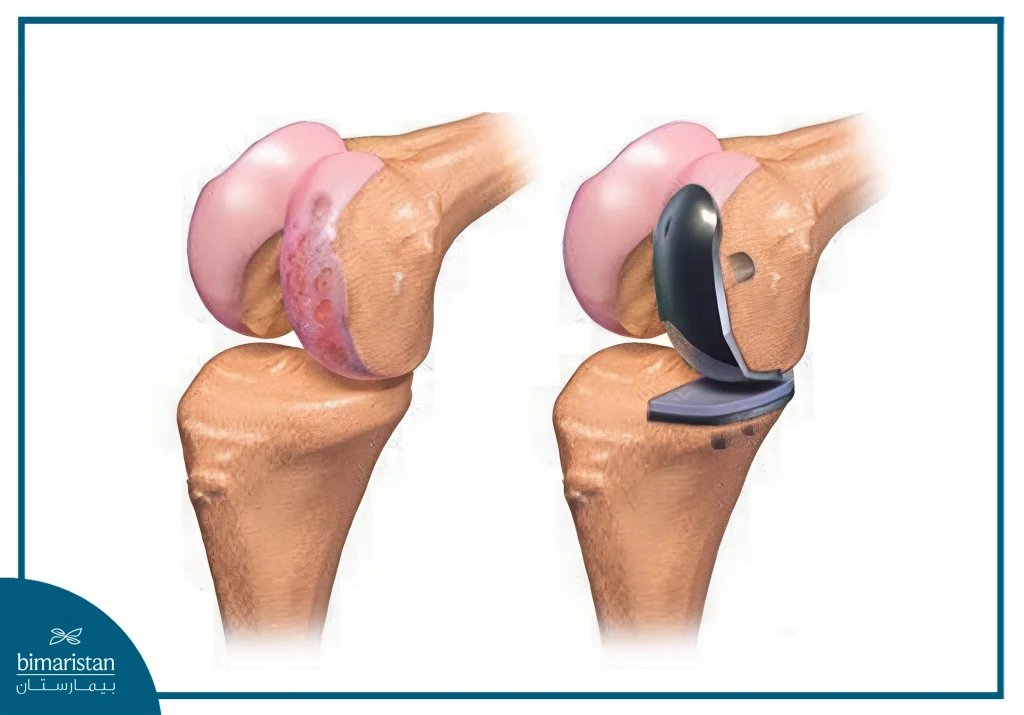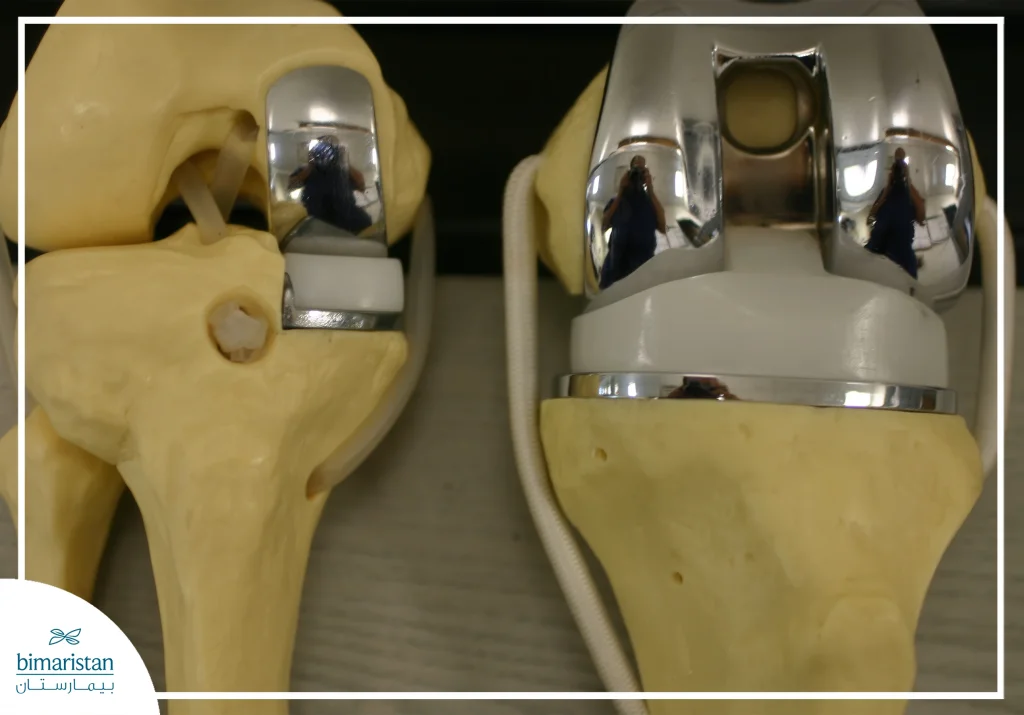Partial knee replacement surgery is a modern medical solution for patients suffering from partial knee damage, without the need for a complete joint replacement. This type of surgery offers a less invasive and more precise alternative, as only the damaged part of the joint is replaced, allowing the healthy parts to be preserved.
This procedure is an ideal option for patients suffering from chronic knee pain due to specific damage, allowing them to return to their normal activities and lives more quickly. In this article, we will discuss the importance of this procedure, its benefits, the advanced techniques used, and post-operative advice to ensure the best possible results.
Introduction to partial knee replacement
Partial knee replacement surgery is performed when a single part of the knee joint is damaged while the remaining parts of the knee are healthy. This procedure preserves the healthy sections of the knee.
The knee joint is divided into three main compartments: the medial compartment (inner part of the knee), the lateral compartment (outer part of the knee), and the patellofemoral compartment (front of the knee between the thigh bone and the patella).
Osteoarthritis or inflammation may affect one of these compartments without involving the others. In some cases, it may progress to involve the entire joint, requiring a total knee replacement surgery.
The implantation of a partial artificial knee joint requires precise techniques and greater expertise compared to a total knee replacement surgery.
It is characterized by a smaller surgical incision and a shorter recovery period compared to total knee replacement surgery.
Additionally, it provides a more natural feeling and better range of motion since the joint surface is not entirely artificial but consists of both natural and artificial components.
Candidates for partial knee replacement surgery
Rheumatoid arthritis, in its advanced stages, causes severe pain that does not respond to medications and leads to impairment of the patient’s mobility, necessitating consideration of joint replacement surgery.
If this inflammation is limited to a single part of the knee, the patient is a candidate for partial joint replacement surgery.
This procedure is suitable for individuals who still have a good range of motion before surgery, in addition to the absence of significant deformity in the joint.
Partial replacement surgery is preferred for patients with good physical activity as it preserves a better range of motion and allows for a quicker return to physical activities compared to total knee replacement surgery.
This procedure is not suitable for patients with severe stiffness in the joint or injury to one of the knee ligaments. Patients with anterior cruciate ligament tear are usually not candidates for partial knee replacement surgery.
Patients with rheumatoid arthritis are not good candidates for the procedure as rheumatoid arthritis usually affects the entire joint.
Each patient’s case is thoroughly and carefully assessed before making the most appropriate decision regarding the type of surgery they will undergo. Whether partial knee replacement surgery provides better results or if total replacement is the better option for the patient’s condition.

Advantages of partial knee replacement surgery over total knee replacement
Partial knee replacement surgery has the following advantages compared to total replacement surgery:
- Smaller surgical incision
- Shorter hospital stay
- Faster recovery and return to daily activities
- Better range of motion
- Higher patient satisfaction with the results
- Lower cost of the procedure
Preparation before partial knee replacement surgery
It is important to inform your doctor about the types of medications you are taking, as they may ask you to stop or adjust some medications before the surgery.
If you have chronic conditions such as heart disease or diabetes, you should consult with specialists in these conditions to determine your readiness and ability to tolerate the surgical procedure.
If you are a smoker, it is recommended that you quit smoking at least 4 to 6 weeks before the surgery as smoking slows down the healing and recovery process of wounds.
It is preferable to visit a physical therapy consultant before partial knee replacement surgery to learn about exercises that can help rehabilitate the knee joint during the recovery period.
On the day of the surgery, you may be asked to avoid eating and drinking for approximately 6 hours before the surgery. It is important to follow the instructions of the specialist doctor.
How is partial knee replacement surgery performed in Turkey?
During the surgery, the surgeon makes a small incision around the knee to access the affected area of the joint.
The surgeon works on removing the damaged tissues and cartilage from the surfaces of both the femur and tibia bones in the affected area.
After excising the damaged areas, the joint surfaces are prepared for the implantation of the artificial component. The artificial implants are custom-sized according to each individual’s condition.
The artificial implants are made of metal and plastic and are designed to glide smoothly against each other, providing smooth knee movement.
In the event that the orthopedic surgeon notices extensive damage to the knee joint during partial knee replacement surgery, they may decide to change the procedure to a total joint replacement. However, this is rare due to the presence of several radiological tests conducted before the surgical replacement to ensure that the injury is partially confined to the knee.
We at Bimaristan Medical Center in Turkey guide you with a team of elite orthopedic surgeons. You just need to contact us for more details.

Post-partial knee replacement surgery
You will be able to move your knee on the same day of the surgery, and you will quickly regain full function of the knee joint. The knee pain will be less compared to a total knee replacement surgery.
You will be introduced to a physical therapist who will assist you in your recovery journey after the surgery by performing specific exercises that help restore proper mobility.
The doctor will prescribe blood-thinning medications to prevent blood clots due to reduced mobility after the partial replacement surgery.
Usually, the patient leaves the hospital within one to two days after the surgery. The person continues with physical therapy at home for a period ranging from two to four weeks after the replacement surgery.
If the recovery phase goes as planned without any complications, the person becomes capable of returning to their normal daily activities after approximately 6 to 8 weeks following the partial knee replacement surgery.
It is advised to avoid vigorous physical activities such as fast running and sprinting, but the person can engage in activities like tennis, skiing, and other low-impact sports. This is one of the reasons that distinguishes partial knee replacement from total replacement.
How long does it take to recover from a partial knee replacement?
Most people need about six weeks to recover after a partial knee replacement, but patients can often begin moving and walking with the help of a companion or a walker immediately on the same day of surgery.
Is walking good after a partial knee replacement?
Walking is certainly beneficial after a partial knee replacement, but orthopedic surgeons recommend only exercising for 20 to 30 minutes per day during the early recovery period.
Risks of partial knee replacement surgery
Usually, the surgery does not come with complications when performed in Turkey by a group of elite orthopedic surgeons. However, no procedure is without the possibility of some complications, including:
- Infection at the surgical site
- Blood clotting
- Stiffness in the knee joint
- Failure of artificial implants and continued knee pain
How long does pain last after a partial knee replacement?
All surgeries are associated with some degree of pain. For partial knee replacement surgery, the severity of pain varies from person to person, but it is generally milder than for a total knee replacement.
After partial knee replacement surgery, some people experience occasional painful twinges, while others report no pain at all and that their knee feels completely normal.
Pain after knee replacement surgery usually subsides within a few months after the procedure, and pain can be controlled with pain medication when needed.
When should walking begin after a partial knee replacement?
Doctors recommend walking on the leg that received the replacement knee within 24 hours of the procedure, using a walker. Physical therapy exercises are then initiated to improve the knee’s flexion and range of motion. Most patients are able to walk without a walker or cane approximately six weeks after knee replacement surgery. Recovery time varies from patient to patient.
Long-term results of partial knee replacement
Most people who have undergone knee replacement surgery report relief from the pain that had been hindering their daily activities.
Prosthetic implants typically last between 15 and 20 years after replacement, and may last more than 25 years. This depends on several factors, such as the patient’s age, physical activity level, and weight.
If the original implant is damaged, a replacement knee joint can be performed through a second surgery to replace the damaged joint.

Post-surgery tips for partial knee surgery
- Pain management: Pain begins to appear once the anesthesia wears off after surgery. Pain can be managed with painkillers such as NSAIDs (ibuprofen or naproxen), as well as opioid painkillers in cases of severe pain, after consulting a doctor.
- Swelling reduction: Elevating the legs above heart level while lying down helps reduce swelling. Ice packs can also be used to reduce blood flow to the surgical site that caused the edema.
- Physiotherapy: The journey with physical therapy and knee joint rehabilitation in Turkey begins on the first day of the surgery. A schedule is developed for appropriate physical therapy exercises based on the patient’s condition.
- Walking and movement: In the first days after surgery, the patient will be unable to walk, so it is necessary to use crutches while walking.
- Weight loss: Weight loss and obesity are the most important measures before and after surgery.
Partial knee replacement surgery costs in Turkey
The price varies depending on the type and size of the implants. The cost of a partial knee replacement in Turkey typically starts at around $6,000.
In conclusion, partial knee replacement surgery is an effective surgical option for patients with partial knee damage, as it provides a solution that preserves the healthy parts of the joint.
Thanks to the advanced technology and high surgical skills available in Turkey, patients can enjoy a faster recovery and less pain, restoring their ability to lead active and vibrant daily lives. If you are considering this type of surgery, consulting with specialist doctors in Turkey ensures you receive excellent medical care and optimal results.
Sources:
- Partial Knee Replacement, Twin Cities Orthopedics, Dr. Thomas Comfort.
- Partial Knee Joint Replacement, London Knee Clinic.
- OrthoInfo


